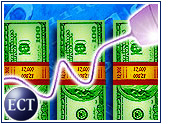
It is a scene that retailers have seen since the world’s first bazaar opened: the slow sales period, complete with idle clerks, empty aisles and languishing goods. E-tailers have come to know these stretches — the low-revenue valleys that lie between peak shopping times — well.
Despite the now-predictable cycle of consumerism, some e-tailers are rebelling against convention, trying to bring in shoppers during slow times.
With tactics that range from replicating the marketing done by offline retailers to using technological advantages unique to the online retail realm, e-tailers are finding that they can squeeze a little more cash from their customers during shopping’s Death Valley days.
Mall Walking
Although the Internet has made online shopping unique, freeing consumers from the need to schlep around stores and interact with other people, there are still some techniques utilized by brick-and-mortar malls that e-tailers can draw on for inspiration.
For example, AOL recently implemented a one-day special for its merchant partners — the online equivalent of a mall-wide sale — and users responded enthusiastically. Done during the gulf between Valentine’s Day and Mother’s Day, the sale was meant to spark shopping at a traditionally slow time.
Although similar events have not been planned yet, AOL senior vice president of commerce Patrick Gates told the E-Commerce Times that the reaction from merchants and customers alike ensures there will be more promotions in the future.
“It was something we did to help our partners through a slow period of the year,” Gates said. “Because of the sale’s success, we’ve started to think of other big events to promote during similar periods.”
Good Timing
In March 2002, and again last fall, Yahoo also held timed sales that included merchant and travel partners as well as Yahoo services.
Of the 1,200 merchants that participated, 200 reported a sales spike of nearly 400 percent over the same time the previous year.
P.K. Van Deloo, brand manager for Yahoo Shopping, told the E-Commerce Times that, in some ways, the site acted like a mall in bringing together merchants and taking advantage of retail innovations.
“Even 10 or 15 years ago, the traditional thinking was that people just shopped around Christmas and didn’t want to shop in the middle of the year because they were on vacation,” he said. “Then the half-year sale was started, and it changed the way people shopped.”
In a similar way, Van Deloo thinks online shoppers are realizing that sales can come at any time, not just when major holidays loom.
Click, Click, Buy
Despite taking lessons from the brick-and-mortar retail world, e-tailers do have certain advantages over their offline brethren when it comes to slow-period sales.
For example, thanks to speedy Webmasters, e-tailers can move more quickly than retailers to launch impromptu sales, lower prices temporarily and put together promotions for select customers. Throwing free shipping into the mix also can boost clicking and buying.
Also, since e-tailers can communicate with frequent customers via e-mail, they can alert them to upcoming sales and provide links to pages that have discounted merchandise.
The e-mail list also can be mined for promotions that reward loyalty with customer-only sales, a tactic that is likely to become more common as consumers grow more comfortable with e-mail sale notices.
Road Runner Sports, for example, has a shopping club that gives members added discounts on top of regular sale prices. Making online shoppers feel more “in the know” with tactics like this, and then rewarding them with lower prices, can boost a bottom line in even the slowest of times.
Area-Wide Focus
As e-tailers become more savvy about how online customers spend their time and money, they also are using that knowledge to bolster off-season sales efforts in other ways.
For instance, when Yahoo discovered that site visitors were researching specific items rather than browsing as they would in a shop, the company struck up content deals with magazines that offered a bevy of reviews, such as PC World.
Yahoo also took note of which items were purchased year-round, not just during holiday periods. Not surprisingly, given the company’s computer-savvy audience, electronics and computers are always popular, with digital cameras selling at the best clip. So, to bolster between-holiday efforts, the site promotes electronics, especially digital cameras, at all times.
E-tailers also have become smarter about promoting gift-giving during non-holiday seasons. Sites like RedEnvelope, Blue Nile and Amazon encourage sending presents that are not tied to holidays or special occasions. As online shoppers become more used to sending gifts “for no reason,” this impulse should improve the times between gift-buying frenzies.
Cycle Shop
However, despite the multitude of strategies and tactics for convincing shoppers to pony up more change in the off-season, e-tailers should be aware that the consumer spending cycle can only be manipulated to a certain degree, IDC analyst Jonathan Gaw told the E-Commerce Times.
“Let’s face it, some periods are just going to be slow,” he said. “If you’re an online florist, you’ve got Mother’s Day and Valentine’s Day, and that’s about it. The rest of the time, you’re working on your compost heap. That’s not a function of being online, it’s a function of retail.”
Even e-tailers that do not sell perishable items like flowers will find that although a spike may result during impromptu, off-season sales, consumer demand likely will settle back to its normal level relatively quickly.
As Gaw noted, “Just because you’re selling online doesn’t mean all the rules have changed.”


























































Social Media
See all Social Media